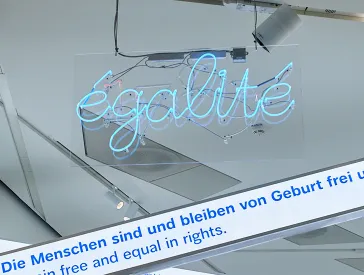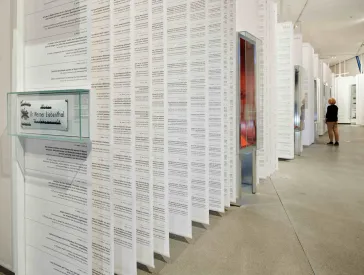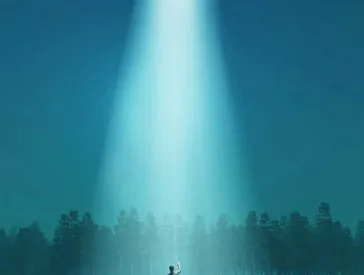An Unequivocal Zest for Debate
Interview with Sharon Adler
Photographer and journalist Sharon Adler was born in West Berlin in 1962 and grew up in Berlin, North Rhine-Westphalia, the Netherlands, and Israel. For the series she co-edits, Jüdinnen in Deutschland nach 1945. Erinnerungen, Brüche, Perspektiven (Jewish Women in Post-1945 Germany: Memories, Ruptures, Perspectives), a collaboration with Germany’s Federal Agency for Civic Education, she interviews Jewish women with varied backgrounds, ages, and professions. The founding editor in chief of AVIVA Berlin, she is also a board member of the ZURÜCKGEBEN Foundation, moderator of the Jewish Quartet and a winner of the Berlin Women’s Prize. In our interview, she speaks about her motivations, her visions for the future, and her own Jewish Berlin.
What is your favorite neighborhood of Berlin?
I love Berlin as a whole! But if push came to shove, I would pick two neighborhoods. First of all, the whole area around Südstern – the Admiralsbrücke, Fraenkelufer, the Marheinekehalle covered market, Chamissoplatz, the cemeteries around Bergmannstrasse. Kreuzberg 61 is definitely my Berlin because I’ve been living here for so long and it unites such a good mixture of young and old, old-timers and newcomers, and people with all kinds of life stories from different generations and origins.
But “my Berlin” is also the old Charlottenburg of the ’20s and ’30s, and also of the ’70s, ’80s, and even ’90s, which holds many personal associations for me. For example, Savignyplatz is inextricably linked in my mind to one of my favorite poems. Written by Mascha Kaléko from exile in America, it ends with the line “Mein Heimweh hieß Savignyplatz” (“My homesickness was called Savignyplatz”). For me, this area – as with Kreuzberg 61 – symbolizes the interchange between past and present and is also one of Berlin’s melting pots. In Charlottenburg, however, that has much more to do with Jewishness. But Kreuzberg is also evolving rapidly with the Fraenkelufer Synagogue, that old spot that many Jewish young people especially have been turning into a new gathering place.
Sharon Adler; photo: Mara Noomi Adler
We are marking two major anniversaries this year: 1700 years of Jewish life in Germany and 350 years of Jewish life in Berlin. What do those dates signify to you?
I must say it gives me some discomfort. Why? Because the anniversary of “1700 years” was imposed on Jews from outside. It’s counting from the year that Kaiser Konstantin first said anything at all about Jewish life. Well, I’m no historian or Jewish studies scholar, but who’s to say that there couldn’t have been any Jewish life on the territory of today’s Germany before 1700 years ago. Then again, the anniversary does also bring opportunities: as a year when Jewish life – and quite different aspects of it – are being made visible across Germany through exhibitions and events of many kinds.
I think the anniversary has two different aspects. First, there’s the aspect of celebrating, of dignified celebration, which raises the question of how both memory culture and present-day Jewish life, which is inseparable from the past – can be jointly approached in a celebratory manner.
The other aspect is the opportunity this anniversary poses for raising awareness of problems, such as antisemitism. After all, you could just as easily rename this anniversary “1700 Years of Antisemitism in Germany”!
And in my view, we also need to consider what it really means that people keep talking about the new “blossoming” of Jewish life. Then you would have to criticize how little attention is given to migrants from the former Soviet Union. The same holds for other issues, such as the failure to recognize school or university diplomas, the impoverishment among former “quota refugees” (Kontingentflüchtlinge) in their old age, and the issue of “ghetto pensions.” These issues ought to be public knowledge, much more so than they are now. This would also help to counter the enduring stereotype of the “wealthy Jew”, for example.
The women you interview for your series on Jewish women in Germany since 1945 come from completely different walks of life, religious orientations, places of origin, and age groups. Does all these women share a commonality across all their differences?
Absolutely. For all their differences, they all invariably have the trauma of the Shoah in common. As Hetty Berg described it in my interview with her: “Even if people didn’t talk about the Shoah, it was always there.” In fact, each of the women I have profiled and interviewed has had their own biographical Shoah experiences, and they are all occupied with the Shoah in their work, even the third generation of young Jews in post 1945 Germany, such as the artist Ella Ponizovsky Bergelson. It’s a very complex story because on the one hand, Jews do not want to be reduced to just the Shoah, and on the other, the Shoah is always present as a fixture in their families. That is something that every interview touches on even if I don’t ask any explicit questions about it. It is for good reason that the series bears the subtitle Memories, Ruptures, Perspectives...
And the other subject that connects all these women in some fashion with each other – warning, cliché trap! – is their zest for dialogue, their zest for analysis, their unequivocal zest for debate. If someone invited them all to a panel discussion, it would be a very lively event that would also give a real picture of female Jewish life in Germany!
The online magazine AVIVA has a section on Jewish Life. How would you characterize Jewish life in Berlin today? Has that shifted in recent years?
I could spend all night on that question. I founded AVIVA in 1999–2000 as an online magazine for women, and actually I didn’t want to create any kind of “ghetto” with that section. I really wanted to include Jewish life as a natural element of all the other sections such as art, culture, literature, politics, and public affairs. But to improve reader usability, the Jewish Life section developed in parallel to the others, but was also integrated. A website like that changes on an ongoing basis.
It was important to me that it should portray Jewish life in the first place. Back then, as I saw it, the Jewish media didn’t adequately portray women, let alone queer Jewish life. And in all the other media, if Jewish women were present at all, they were exclusively associated with the Shoah. Jewish women were only ever exotic. Most of all, there was only writing about Jewish women; there were very few Jewish journalists or editors who wrote about Jewish subjects in the (non-Jewish) press.
As for the change that Jewish Berlin has undergone... If we look back a century at the 1920s and ’30s, Berlin was already a melting pot, reinforced by Jewish cultures, primarily from eastern Europe. And today, a hundred years later, Berlin is a magnet once again, primarily for Israelis who come here to live, work, and create. Literature, visual art, theater, film, performance. That’s something this thematic year is indeed making more visible. It was already happening in the ’70s and ’80s, but this is a completely different generation now and a much younger one. It’s giving the city a new face once more.
And the Jews from the former Soviet Union are plainly a very important voice. Their arrival was a challenge for the Jewish Communities because overnight they became the majority of community members even though most of them were neither socialized as Jewish, nor spoke German! But as a result, there is a new visible diversity of a Jewish life today. And that should be highlighted when people talk about Jewish life. But it isn’t. The old-timers had mostly been Shoah survivors, and the “Soviet” Jews had entirely different experiences of the Nazi era. They saw themselves as victors, not victims. That has drastically changed Jewish Berlin.
If you were to curate an exhibition at the JMB, what would you exhibit?
It would be important to me to exhibit women’s work and their impact because the share of women in public collections and among solo exhibitions of contemporary art still remains notoriously low. There have been several studies into how low.
For example, I would be delighted to exhibit the works by the fellows of the Zurückgeben foundation. This foundation, dedicated to supporting Jewish women in the arts and sciences, for which I have volunteered as a board member since 2013, has been around since 1994, and it has been able to support numerous projects in recent years. It would be fantastic to raise the visibility of this broad range of artists, writers, musicians, and scientists in some fashion or another.
Of course I would love to exhibit the photographs I’ve taken of my interview subjects for the Jewish Women in Post-1945 Germany project. The photos aren’t clean or staged studio portraits, but rather reportage-style shots mostly taken under natural light. They could be accompanied by excerpts from the interviews with the women’s biographical details and life stories.
And then I could also imagine curating an exhibition of works by the artist Shlomit Lehavi. We met each other through her first exhibition in 2012 in Berlin, the installation Time Sifter, and I am proud to be married to her.
So in a nutshell, more works by women. That could even be a major collective exhibition consisting of the areas I mentioned, Jewish Women since 1945, the Zurückgeben Foundation, and works by Shlomit Lehavi. And for that alone we would need at least three rooms in the museum.
What challenges does the Zurückgeben Foundation face? And perhaps you can also go into why it is necessary?
The biggest difficulty or challenge in the foundation’s work is soliciting donations. It’s easier to convince people to donate to animal conservation or environmental protection. That kind of donation speaks for itself. A contribution to the Zurückgeben foundation requires an explanation, starting with the name. Because for non-Jewish people, making such a donation is always tied to grappling with their own family histories. “Of course,” almost everyone will say. “Of course I’m against antisemitism, and of course I’m in favor of restituting works that were formerly in Jewish possession.” But when it comes to people examining their own life stories, not so much has happened unfortunately. For the foundation, it’s important that this is not about assigning blame, but about actively processing what happened.
And when we request donations or contributions to our endowment, it’s about honoring the work of Jewish artists, scientists, and women’s rights activists in Germany, women who were forced to migrate, fled, or were deported. The foundation got its name from Marguerite Marcus, who was one of the Jewish women involved in founding it in the early 1990s. In commemoration of the women who were no longer there.
Why women? Because of the existential destruction of Jewish families’ assets, women in particular lack the security of family structures. They’re missing family support, a financial cushion. Today, the Zurückgeben foundation also wants to raise awareness of and call attention to the fact that many people profited from the Nazi era, which has repercussions to this day. Even in the third generation, a person has completely different standing if their grandfather or great-grandfather took over a doctor’s office with all its equipment for proverbial pennies on the dollar; people’s entire life’s possessions were publicly auctioned off.
Meanwhile, the Jewish people who returned from exile or the camps and consciously decided to live in Germany, whether East or West, had to confront the ruins of their old lives and rebuild them from scratch. And in terms of reparations: people were subjected to a very degrading situation there. They had to prove what had been expropriated and where, down to the last cent, and the whole process took decades if the money was ever paid out at all. And this discrepancy lingers into the current generation.
As part of the 2013 exhibition The Whole Truth, you participated six times as a “living display” in the “Jew in the Box” project, which was not uncontroversial. What experiences left the biggest impression on you? If you had the chance, would you participate again now? What would people ask you today?
Well, first of all, I have to say that exhibition was very good. It was designed to be provocative and it fulfilled the brief. I would take part in it again, absolutely! My most memorable experience was the very first question I was asked. It came from a married couple, both in their fifties, and the husband asked me in all seriousness: “Something I’ve always wanted to know: why do Jews have so much influence?” At first I thought he was joking and trying to start a conversation about the origins of those kinds of stereotypes, but no. He was completely serious. After the initial shock, I asked him in what area he thought we were so influential. And without having met me or knowing what I did for a living, he replied, “in the media.” I have to say I truly found that shocking.
Truth be told, all Jewish people are always in a box on a day-to-day basis, if an invisible one. For example, when we’re expected to give our opinions about Israel and have to become experts on all sorts of topics connected to Judaism. In that sense, the box at the JMB is really a metaphor for all Jewish people in Germany.
Another question was: are camels kosher? I didn’t know the answer at the time! There were smart questions from people of many different ages and backgrounds, both prepared and off the cuff, people curious about all areas of Jewish life and Jewish issues. It gave me a solid picture of many non-Jewish people’s ignorance about Judaism. And it also made clear that Jewish people don’t need to be experts on every Jewish topic.
Sharon Adler as „Jew in the Box“ as part of the exhibition “The whole Truth” at the Jewish Museum Berlin, 2013; Jewish Museum Berlin, photo: Linus Lintner
Unfortunately, if the exhibition were held today, I assume the questions would be the same. But that said, I do think that in the years since, Jewish life has made many more inroads into public awareness and public space thanks to a large number of new initiatives, but also thanks to many online formats, such as the Jewish Quartet, which was initiated by the Amadeu Antonio Foundation and which I moderate. Four Jewish women debate issues of society, politics, ascribed roles, self-empowerment, religion, literature, and philosophy. It’s a fantastic format. Through it we reach an audience whose only previous associations with Judaism were the Shoah and antisemitism, or men with sidelocks and kippahs.
What is a Kippah?
Kippah (Hebrew for cap), plural: kippot; ritual skullcap worn by Jewish men
Many of my projects are absolutely in reaction to antisemitism, such as the photography and interview project JETZT ERST RECHT! – STOP ANTISEMITISMUS (ENOUGH ALREADY! – STOP ANTISEMITISM), which was also supported by the Amadeu Antonio Foundation. I launched that project after the Yom Kippur 2019 attack on the Halle synagogue as a way to represent Jews’ experiences of antisemitism and their own perspectives and strategies beyond the statistics. There are many intersections in my work and I always try to make connections between topics and people.
AVIVA published an open letter headlined We Will Not Be Divided and signed by various Jewish-Muslim organizations and alliances, alliances that speak out against both anti-Muslim racism and antisemitism. What does that letter mean to you personally and what do you hope to achieve with it?
I hope that every kind of dialogue will have an impact and was delighted when this was a coming together and not a point of friction. I wish for continued alliances between Jewish and Muslim initiatives. And I would hope to see the media in Germany report more on these kinds of initiatives, for example Women Wage Peace, which is a coalition between Jewish Israeli and Arab Israeli women who demonstrate together for peace in Israel.
In 2014, I personally launched the project Schalom Aleikum: Als Freundin hinzufügen (Shalom Aleikum: Friend Another Woman), a project of dialogue between Jewish and Muslim women. For the project, I matched different pairs of women: two artists, two scientists, two graduating high school students, two educators. I tried to spark dialogue over the little things. Now, in 2021, some of those women are still in contact and have even developed friendships, which pleases me a great deal.
The letter was perfectly timed. It would have been nice if every major German newspaper had reprinted it.
You grew up in West Berlin. How did that shape you? What was your experience of Reunification like?
I had mixed feelings about Reunification. Because I had my eyes on the resurgence of German nationalist sentiment, and not only with the many German flags that were flapping.
So many of them. For me, German flags are always especially hard to bear. I get a queasy feeling. And I’m also skeptical of this nationalist behavior during soccer World Cups and so on.
After all, the people who grew up in the East were watching as the chant of “We are the people” transformed into “We are ONE people” and they were also alarmed by it.
Back during Reunification, I also witnessed the lack of representation of Jewish or migrant perspectives – and in some cases fears – regarding the dissolution of the intra-German borders. And that’s still how I feel about it.
The interview was conducted by Katharina Wulffius and Marie Naumann, June 2021
Citation recommendation:
Katharina Wulffius, Marie Naumann (2021), An Unequivocal Zest for Debate. Interview with Sharon Adler.
URL: www.jmberlin.de/en/node/8079


